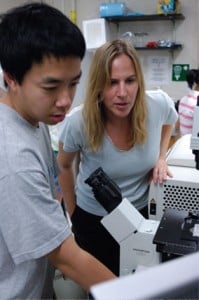 When the Engineering in Oncology Center opened at Hopkins in 2009, Sharon Gerecht found herself at the crossroads of several different disciplines. That position ultimately put her in the driver’s seat for a remarkable ride. In February, she received an NSF Career Award, marking recognition of her work at the juncture of medicine and engineering.
When the Engineering in Oncology Center opened at Hopkins in 2009, Sharon Gerecht found herself at the crossroads of several different disciplines. That position ultimately put her in the driver’s seat for a remarkable ride. In February, she received an NSF Career Award, marking recognition of her work at the juncture of medicine and engineering.
The grant for $450,000 will help fund her research on the formation of microvasculature from stem cells, which can also be used in creating vascularized tissue to repair damaged tissue.
“For example, the growth of new blood vessels into tissue without vasculature happens in cancer when the tumor grows,” explains Gerecht, an assistant professor of chemical and biomolecular engineering. In seeking to understand how blood vessels grow in cancer, Gerecht has a twofold goal: first, that by understanding its principles, researchers might slow or halt the disease growth; and second, that researchers can adapt those principles to regenerate damaged tissue.
To discover how these structures for vasculature work, Gerecht’s team is collaborating with a variety of specialists at Johns Hopkins, including John Harmon, director of surgical research at the Hopkins Bayview campus. Together the team is collaborating to explore the repair of skin burns.
Gerecht’s lab probes the tissue where this vascularization takes place, using a wide range of techniques from chemistry, biology, and engineering. Her team searches for phenomena that cue the growth of the vessels and the underlying principles of that process. Those cues include hypoxia, the deprivation of oxygen to tissues, which triggers cancer cells to more aggressively invade surrounding normal tissues where oxygen is more plentiful.
A related area of focus for Gerecht is the extracellular matrix (ECM), a three-dimensional structure that essentially defines connective tissue. Working with Gregg Semenza, founding director of the Vascular Program at the School of Medicine, Gerecht and her team are teasing out the properties of the ECM, to get a better handle on how cancer spreads. “Normal cells live in a flexible scaffold, but cancer cells create a rigid scaffold that they climb through to invade normal tissue,” Semenza explains.
Just as challenging as probing this process in tissue, noted the NSF in giving Gerecht the CAREER Award, is the interdisciplinary approach that she has pursued. Gerecht shifts adroitly from one technical approach to another.
“I’m kind of in the middle,” she says of her role between the team’s engineers and biomedical researchers. “Engineers like to quantify things and formulate complex phenomena,” she says. “Life scientists tend to describe regulatory pathways. These are two different perspectives.”




